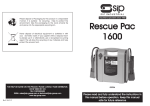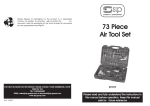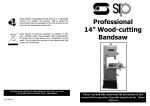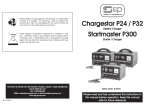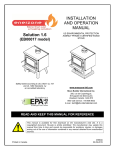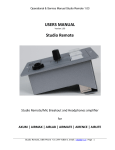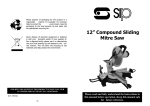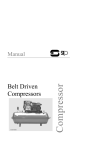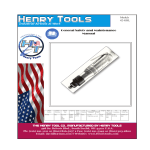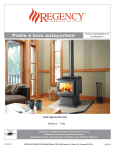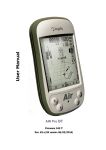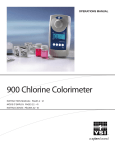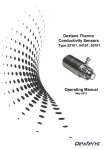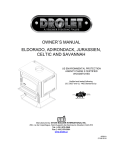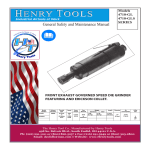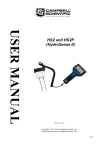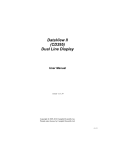Download 01566 1_5hp oil-less compressor SIP 060913
Transcript
Please dispose of packaging for the product in a responsible manner. It is suitable for recycling. Help to protect the environment, take the packaging to the local amenity tip and place into the appropriate recycling bin. Never dispose of electrical equipment or batteries in with your domestic waste. If your supplier offers a disposal facility please use it or alternatively use a recognised re-cycling agent. This will allow the recycling of raw materials and help protect the environment. FOR HELP OR ADVISE ON THIS PRODUCT PLEASE CALL OUR CUSTOMER SERVICE HELP LINE : 01509 500400 Ref:060913 28 Airmate TS1.5/6 Oil-less Air Compressor Please read and fully understand the instructions in this manual before operation. Keep this manual safe for future reference 1 DECLARATION OF CONFORMITY DECLARATION OF CONFORMITY WE SIP LTD GELDERS HALL ROAD SHEPSHED LOUGHBOROUGH LEICESTERSHIRE LE12 9NH Declare that the Airmate TS 1.5/6 Oil-less Air Compressor SIP Pt No: 01566 Complies with the following EEC Directives their supporting Statutory Instruments and the relevant standard where applicable: 97/23/EC 98/37/EC 73/23/EEC 89/336/EEC 2000/14/EC Pressure Equipment Directive AD 2000 Machinery Directive EN 1012-1:1996 Low Voltage Directive EN 1012-1:1996 EMC Directive EN 61000-6-3:2001 EN 61000-3-2:2000 EN 61000-3-3+A1:2000 EN 61000-6-1:2001 Noise directive EN ISO 3744:1995 Signed: Joint Managing Director Date: 15 February 2006 2 27 NOTES CONTENTS 26 Page No. Description 3 Contents 4 General Safety Instructions 6 Specific Safety Instructions 6 Safety Symbols Used Throughout This Manual 7 Safety Symbols 7 Safety Devices 8 Technical Specifications 8 Guarantee 9 Accessories 10 Getting To Know Your Compressor 11 Specified Conditions Of Use 12 Electrical Connection 13 Assembly Instructions 14 Operating Instructions 19 Care And Maintenance 23 Troubleshooting 24 Exploded diagram 25 Parts List 26 Notes 27 Declaration Of Conformity 3 GENERAL SAFETY INSTRUCTIONS Please read the following instructions carefully, failure to do so could lead to serious personal injury. When using compressors, basic safety precautions should always be followed to reduce the risk of fire, electric shock and personal injury. Read all these instructions before operating the tool and save this user manual for future reference. SIP recommends that this compressor should not be modified or used for any application other than that for which it was designed. If you are unsure of its relative applications do not hesitate to contact us using the telephone number on the back of this user manual, and we will be more than happy to advise you. KNOW YOUR POWER COMPRESSOR AND AIR TOOLS: Read and understand the owner's manual and labels affixed to the compressor / tools. Learn their applications and limitations, as well as the potential hazards specific to it. DO NOT USE THE COMPRESSOR IN DANGEROUS ENVIRONMENTS: Do not use the compressor in damp or wet locations, or expose it to rain. Provide adequate space surrounding the compressor during use. Do not use in environments with a potentially explosive atmosphere. KEEP CHILDREN AND UNTRAINED PERSONNEL AWAY FROM THE WORK AREA: All visitors should be kept at a safe distance from the work area. STORE THE COMPRESSOR AND ANY AIR TOOLS SAFELY WHEN THEY ARE NOT IN USE: All tools should be stored in a dry, locked cupboard wherever possible and out of the reach of children. USE SAFETY GOGGLES AND EAR PROTECTION: Wear CE approved safety goggles at all times, Normal spectacles only have impact resistant lenses, they are NOT safety glasses. A face or dust mask should be worn if the operation is dusty and ear protectors (plugs or muffs) should be worn, particularly during extended periods of operation. STAY ALERT: Always watch what you are doing and use common sense. Do not operate the compressor when you are tired or under the influence of alcohol or drugs. DISCONNECT THE COMPRESSOR FROM THE MAINS SUPPLY: When not in use and before servicing. AVOID UNINTENTIONAL STARTING: Make sure the switch is in the OFF position before connecting the compressor to the mains supply. NEVER TURN THE COMPRESSOR ON OR OFF WITH THE MAINS SWITCH: The compressor should only be turned on or off with the on-board pressure switch, this will allow for the correct venting of air between start up / shut down. DO NOT ABUSE THE MAINS LEAD: Never carry the compressor by the mains lead or pull it to remove the plug from the mains socket. Keep the mains lead away from heat, oil and sharp edges. If the mains lead is damaged, it must be replaced by the manufacturer or its service agent or a similarly qualified person in order to avoid unwanted hazards. 4 PARTS LIST Ref No. Description Ref No. Description 1. Cylinder head bolt 26. Stator 2. Cylinder head 27. Rotor 3. Head gasket 28. Capacitor 4. Valve plate 29. Star washer 5. Valves 30. Nut 6. Cylinder gasket 31. Motor cover 7. Valve plate centre gasket 32. Elbow 8. Piston seal bolt 33. Delivery pipe 9. Piston seal cover 34. Bleed pipe 10. Piston seal 35. Valve 11. Cylinder 36. Bolt 12. Crankcase gasket 37. Washer 13. Crankcase 38. Spring washer 14. Cam 39. Nut M8 15. Con-rod (piston) 40. Receiver (tank) 16. Bearing 41. Rubber foot 17. Fan 42. Drain valve 18. Washer 43. Adaptor 19. Bolt 44. Outlet valve 20. Bolt 45. Safety valve 21. Washer M5 46. Regulator 22. Bolt M5 x 95 47. Pressure gauge 23. Motor end plate 48. Pressure switch 24. Spacer 49. Mains lead 25. Bearing 6202-2rs 25 EXPLODED DIAGRAM GENERAL SAFETY INSTRUCTIONS….cont CHECK FOR DAMAGED PARTS: Before every use of the compressor, a guard or other part that is damaged should be carefully checked to determine that it will operate correctly and perform its intended function. Check for alignment of moving parts, free running of moving parts, breakage of parts, and any other conditions that may affect its operation. A guard or other part that is damaged should be correctly repaired or replaced by an authorized service centre unless otherwise indicated in this instruction manual. Have defective switches replaced by an authorized service agent. Do not use the tool if the switch does not turn it on and off. KEEP ALL GUARDS IN PLACE: And in full working order. MAINTAIN TOOLS WITH CARE: Keep the compressor and air-tools clean for the best and safest performance. Follow instructions for lubricating and changing accessories. Always keep the hand grip on air-tools clean, dry and free of oil and grease. USE ONLY RECOMMENDED ACCESSORIES: Consult this user manual for recommended accessories. Follow the instructions that accompany the accessories. The use of improper accessories may cause hazards and will invalidate any warranty you may have. USE THE RIGHT TOOL: Do not use a tool or attachment to do a job for which it was not designed. DO NOT FORCE THE TOOL: It will do the job better and more safely at the rate which it was designed. HAVE THE COMPRESSOR REPAIRED BY A QUALIFIED PERSON: The compressor is in accordance with the relevant safety requirements. Repairs should only be carried out by qualified persons using original spare parts, otherwise this may result in considerable danger to the user. NOT SUITABLE FOR BREATHING: Do not use the compressed air produced from this compressor for breathing purposes or for charging breathing apparatus unless the air has been filtered using filters designed specifically for this purpose. DO NOT DIRECT AT YOURSELF OR OTHERS: Never use compressed air for cleaning clothing or blow it directly onto skin, as this may result in injury from foreign objects in the air stream. TAKE CARE WHEN CLEANING: Never use flammable or corrosive liquids to clean the compressor. CHECK ALL PIPES AND HOSES: Ensure all pipe work and hoses connected to the compressor are of the correct size, suitable for the working pressure and are well sealed at the joints. 24 5 SPECIFIC SAFETY INSTRUCTIONS • • • • • • • • • • • Ensure that all operators of this compressor know how ALL of the controls work, particularly how to stop the compressor suddenly should it be required. Before carrying out any adjustments or maintenance, make sure that the pressure switch is in the off position, the plug has been removed from the mains supply and that the tank has been fully drained of any air. After carrying out any adjustments or maintenance, make sure all components have been fitted correctly and that all joints have been correctly sealed so that no air can leak. Never touch the cylinder heads, NRV, delivery pipe or any exposed metal components whilst the compressor is running, there is a very real chance of burning due to the high temperatures reached during normal operation. Allow the compressor to fully cool before any adjustments or maintenance. Never move the compressor with the tank under pressure. Never operate the compressor without the air filter fitted. Never use an air tool which has a higher flow rate than the compressor, this will lead to unwanted damage to the compressor. Allow sufficient room around the compressor during use to allow the air to flow around the motor to cool it. Remember to drain the moisture from the tank on a daily basis. Ensure that the compressor is well away from any operations that may cause dust or vapour that could “clog” up the air filter and so put un-wanted stress on the motor / pump unit. SAFETY SYMBOLS USED THROUGHOUT THIS MANUAL Danger / Caution: Indicates risk of personal injury and/or the possibility of damage. TROUBLESHOOTING Problem Possible cause Excessive (more than 10 • cycles in 1 hour) starting • and stopping. • Air leak / s. Compressor capacity too low. Compressor never reaches • full pressure. • • • • • Air leak. Drain valve is open or faulty. Damaged head / cylinder gasket. Damaged / faulty valve plate. • • • Use the drain valve to empty the water from the receiver. Check all joints etc and seal as necessary. Check how much air is required by the tool, purchase relevant tool / compressor that match up. Check all joints etc and seal as necessary. Check the drain valve and close or replace if necessary. Check gaskets and replace as necessary. Check valve plate and replace as necessary. Air leaks at pressure • switch after the compressor has stopped running. Problem with the (non return valve). NRV • Check the pastille and spring in the NRV, clean / replace as necessary. Motor “buzzes” but does • not run up. Low voltage in power supply. Extension lead cross section Ø too small. Motor capacitor is faulty. • • Check the supply. Excessive air in receiver. • • Excessive moisture in discharge air • • High humidity in atmosphere. Note: Supplementary information. • • Replace the extension lead with one with a larger cross section Ø. Have the capacitor tested and replace as necessary. Use the drain valve to empty water from the receiver. Operate the compressor in a less humid atmosphere, or use a filter regulator (or similar). Note: Water condensation is not caused by compressor malfunction. CAUTION: The warnings and cautions mentioned in this user manual can not cover all possible conditions and situations that may occur. It must be understood by the operator that common sense and caution are factors which cannot be built into this product, but must be applied. 6 • Receiver full of water. • • Warning: Risk of electrical injury or damage! Possible solution 23 CARE AND MAINTENANCE….cont SAFETY SYMBOLS When using the compressor, it is advisable to ensure the operator as well as those in the area wear ear protection, particularly during extended periods of use. When using the compressor always ensure the operator as well as those in the area wear eye protection. NRV (non return valve) • • • NRV pastille NRV nut Remove the pastille and spring. Check and replace where necessary. Follow these instructions in reverse to refit the nut etc. Some applications can cause dust or vapour to become airborne which have the potential to be highly toxic; always wear a face mask during these operations, as well as ensuring the area is well ventilated. SAFETY DEVICES Checking the safety valve: Every few months or so, the safety valve should be tested to ensure that it works correctly. Caution! This operation has the potential to cause hearing damage as well as causing particles to become airborne. Always wear the appropriate safety equipment. • • ⇒ ⇒ Locate the safety valve. With pressure in the receiver (tank), pull the safety valve ring sharply and quickly release it back to its original position. If it is working correctly there will be a quick release of air. If there is no release of air; the safety valve should be replaced. The regulator sets the outlet pressure to safe levels for use with many different airtools. The pressure switch controls safe operation of the motor, and also sets the cut-out pressure. The safety valve ensures that the system never reaches dangerous levels of pressure should any faults / problems occur. The motor cover protects the user from any moving parts that could otherwise cause unwanted injury or damage. 22 7 TECHNICAL SPECIFICATIONS CARE AND MAINTENANCE….cont Air filter: Part number 01566 Input voltage 230v / 50 hz Input fuse rating 13 amps Motor 1.5 hp Speed 2850 rpm Piston displacement 7 cfm (198 L/Min) Maximum free air delivery 4.6 cfm (130 L/Min) Free air delivery 4.0 cfm (113 L/Min) Maximum air pressure How often the air filter needs to be changed / cleaned depends largely on how often the compressor is used as well as the ambient conditions in which it is used. A general rule would be to check it every month or so. It is possible to change the complete air filter assembly by simply removing the old one and replacing it. If the plastic section does not need replacing, it is possible to just clean / replace the filter element. • Split the air filter to reveal the filter element. 118 psi (8 Bar) Sound pressure level 72 dB(A) Sound power level 92 dB(A) Receiver size 6 lt Number of air outlets 1 Type of outlet Air filter element 1/4” bspt male • • • GUARANTEE Remove the element and either replace it or rinse it with soap and water. Allow the element to dry completely before re-fitting it to the filter assembly. Re-fit the element and “snap” the cover of the filter assembly back together, ensuring that all 3 “tabs” are fully located. Guarantee: Checking the NRV pastille: This sip oil-less air compressor is covered by a 12 month parts and labour warranty covering failure due to manufacturers defects. This does not cover failure due to misuse or operating the machine outside the scope of this manual. Again, depending on the amount of use the compressor has, the NRV pastille should be checked from time to time to ensure that it is not too brittle or cracked. Caution! It is vitally important that the air is fully drained from the compressor before this operation is carried out. Never remove any parts from the compressor whilst it is under pressure. In the unlikely event of warranty claims, contact your distributor or contact our help line on the back page of this manual. Note: Proof of purchase will be required before any warranty can be honoured. 8 • • • Allow the compressor to fully cool and remove the cover. Locate the NRV (non return valve) on the side of the receiver (tank). Loosen (turn clockwise) and remove the NRV nut with the relevant spanner / socket (not supplied). 21 CARE AND MAINTENANCE….cont ACCESSORIES B A Cylinder head bolts: These should be checked and re-tightened after the first days running, after 50 hours, and thereafter every 4 months. The cylinder head needs to be completely cool before carrying out this operation. (Torque setting 10Nm or 6 ft/LB). • • Remove the air filter. Loosen and remove the 2 allen bolts on the top of the cover (see below). C Cover retaining bolts • The cover can now be removed - pull upwards to reveal the cylinder head. Cylinder head Cylinder head bolts • • Tighten the bolts to the prescribed torque. Follow these instructions in reverse to re-fit the motor cover. Caution: Never run the compressor with this, or any covers removed. 20 Ref: Description Qty A Main compressor unit 1 B Air filter 1 C Instruction manual 1 IF ANY OF THE ABOVE ITEMS ARE MISSING or DAMAGED; CONTACT YOUR DISTRIBUTOR IMMEDIATELY. 9 GETTING TO KNOW YOUR COMPRESSOR CARE AND MAINTENANCE Caution! Always ensure that the compressor is turned off and that the plug is removed from the mains supply before carrying out any adjustments or maintenance. E F Care and Maintenance (daily checks): Draining the condensation from the receiver (tank): Condensation build up inside the receiver (tank) is normal during operation, and should be drained on a daily basis. Before this operation is carried out, it is advised that the pressure is released from the receiver (tank) by opening one or both of the air outlets. Caution! This operation could lead to excessive noise levels and lead to potentially dangerous particles becoming airborne. Take care when opening the valves - Ensure anyone in the area is wearing the correct safety equipment, and open the valve / s slowly. D G H C I A B J A M L • The drain valve is located on the underside of the receiver (tank). Simply turn the valve anti-clockwise until the condensation is released. K Ref: Description Ref: Description A. Rubber feet H. Outlet pressure gauge B. Drain valve I. Receiver (tank) pressure gauge C. Receiver (tank) J. Mains lead D. Motor cover K. Safety valve E. Carrying handle L. Pressure regulator F. Air filter M. Air outlet G. Pressure switch 10 • Note: Take care when opening the valve - there is no need to completely remove the valve screw. • Once all of the condensation has been drained ensure that the valve is fully closed. Check for air leaks: During, before and after operation check for leaks from the compressor, fittings, delivery lines and couplings and re-seal as necessary. Remember, even small leaks can cause significant wastage of compressed air, costing you both for extra energy used and reduced compressor life. 19 OPERATING INSTRUCTIONS….cont SPECIFIED CONDITIONS OF USE Fitting tools to the compressor: This compressor is designed to safely compress air and deliver it to many different air tools and applications. • Put a few turns of PTFE tape around the threads of the air outlet on the compressor. Whilst the compressor should give you many years of trouble free operation (with the correct use and maintenance), it should be understood that due to its size and power the compressor should not be used in industrial environments where the compressor would be expected to produce large amounts of air on a day to day basis. Always check the requirements of the air-tool / application to ensure that the compressor can safely produce the amount as well as the quality of air required. • • Fit an air hose over the air outlet and turn clockwise until the fitting is hand tight. Fully tighten the fitting with a spanner (not supplied), this will ensure that no air will leak from the fitting. Caution: Use, other than that specified is not permitted. Note: An alternative to the above method would be to use quick coupling connectors and their relevant adaptors. • • Put a few turns of PTFE tape onto the threaded section of the air inlet on the airtool. Fit the airline over the inlet bush and completely tighten the fitting to ensure that no air will leak from it. Operating the outlet valve: • • To open the outlet valves simply slide the brass section forwards (see left). To close the valve, simply slide the brass section backwards, this will cut the airflow completely. 18 11 ELECTRICAL CONNECTION OPERATING INSTRUCTIONS….cont Connecting to the power supply: To set the regulated pressure: This SIP compressor is fitted with a standard 230v ~ 13 amp plug. Before using the compressor, inspect the mains lead and plug to ensure that neither are damaged. If any damage is visible have the compressor inspected / repaired by a suitably qualified person. If it is necessary to replace the plug a heavy duty impact resistant plug would be preferable. The pressure at the outlet is set by turning the knob on the regulator until the required pressure is displayed on gauge A. The wires for the plug are coloured in the following way: Yellow / green Blue Brown Earth Neutral Live • • • If the required pressure is lower than that being displayed on gauge A: • • As the colours of the wires may not correspond with the markings in your plug, proceed as follows: The wire which is coloured blue, must be connected to the terminal marked with N or coloured black. The wire which is coloured brown, must be connected to the terminal, which is marked L or coloured red. The wire which is coloured yellow / green should be connected to the terminal which is coloured the same or marked Ensure all valves etc are fully closed. Turn the compressor on and allow it to reach its full pressure. Check what pressure is being displayed on gauge A. Turn the regulator knob anti-clockwise until the gauge displays the required pressure. Tighten the red locking ring against the knob to hold the pressure. If the required pressure is higher than that being displayed on gauge A: • • Turn the regulator knob clockwise until the gauge displays the required pressure (up to 8 bar). Tighten the red locking ring against the knob to hold the pressure. Always secure the wires in the plug terminal carefully and tightly. Secure the cable in the cord grip carefully. Warning: Never connect live or neutral wires to the earth terminal of the plug. Only fit an approved plug with the correct rated fuse (13 amp). If in doubt consult a qualified electrician. Note: Always make sure the mains supply is of the correct voltage and the correct fuse protection is used. In the event of replacing the fuse always use a 13A fuse. Locking ring Regulator knob Note: If an extension lead is required in order to reach the mains supply; ensure that this too is rated for the correct voltage and fuse rating (230v ~ 13 amps). Note: The cross section of the extension lead should be checked so that it is of sufficient size so as to reduce the chances of voltage drops. 12 Note: As the 2nd outlet (outlet B) is un-regulated, it should only be used for non pressure sensitive air-tools / applications. 17 OPERATING INSTRUCTIONS….cont ASSEMBLY INSTRUCTIONS Warning: Never start or stop the compressor by pulling the plug from the mains supply, or with the mains on / off switch. Only ever use the red knob on the pressure switch explained on page 15. There is very little assembly required before this compressor can be put into service. Out of the box the only thing that needs to be fitted is the air filter. Fitting the air filter: Setting the outlet pressure: There is 1 outlet and 2 pressure gauges on this compressor; • • Gauge A - This gauge shows the outlet pressure set by the regulator. Gauge B - This one shows the pressure in the receiver (tank). • Outlet - The outlet pressure here will be that set by the regulator, as displayed by gauge A. • The air filter should be fitted towards the rear of the pump unit (as shown above). • To fit the air filter, simply line up the threaded section with the hole on the pump unit. Turn the air filter clockwise to secure, take care not to cross thread the air filter as this will damage the threads. Gauge A Outlet Gauge B • • • Whilst the compressor is running, gauge B will keep rising until the maximum pressure is achieved (around 8 bar) and the motor stops running. Gauge A will keep rising until the regulated pressure is achieved, if this pressure is less than the maximum, the compressor will keep running until the maximum pressure is achieved. 16 Caution: Never run the compressor without the air filter fitted. This will reduce the chances of foreign matter getting into the pump and causing unwanted damage. 13 OPERATING INSTRUCTIONS OPERATING INSTRUCTIONS….cont Starting the compressor: Standard components: This section gives a brief guide to the various components on the compressor and why they are there. Item name Explanation ⇒ Motor / pump unit The motor produces the rotary power which the pump unit utilises to compress the air. ⇒ Receiver (tank) The receiver (tank) is the cylinder in which the compressed air is stored. ⇒ Pressure switch Starts and stops the motor / pump unit automatically when the compressed air reaches the set levels. ⇒ Pressure regulator Regulates the pressure at the outlet valve to enable many different tools / operations to be carried out with the compressor. ⇒ Receiver pressure gauge Shows the pressure that has built up in the air receiver (tank). ⇒ Outlet pressure gauge Shows the outlet pressure that has been set by the regulator. ⇒ Non return valve (NRV) Prevents the compressed air in the receiver from bleeding back through the pump unit / pressure switch. ⇒ Delivery pipe Delivers the compressed air from the pump unit to the receiver (tank). ⇒ Bleed pipe The back pressure in the delivery pipe and pump unit is exhausted through the bleed pipe when the pressure switch turns the motor / pump unit off. ⇒ Air filter Filters the intake air to reduce the amount of airborne particles that get into the pump unit. ⇒ Drain valve Allows the user to drain the moisture that builds up in the receiver (tank) during normal operation of the compressor. 14 After completing the installation of the air filter the compressor is ready to be put into operation. Ensure the drain valve and outlet valves are fully closed (see operating the outlet valves). • • • Connect the mains lead to a supply that matches the specification label. Pull the red knob on the pressure switch upwards. The compressor will now start to run. Note: You may notice a noise that sounds like air leaking after the compressor has started to run. This is normal and will stop once the pressure in the receiver (tank) has reached a set pressure (normally around 10-15 seconds). • • • The compressor will now continue to run until it has reached its maximum pressure (8 bar). Once the maximum pressure is reached, the pressure switch will automatically turn the motor / pump unit off. The motor / pump unit can be stopped at anytime by firmly pressing the red knob down and into the off position. • The pressure switch is fully automatic and will operate the motor / pump unit once the stored air in the receiver (tank) drops below a set level (around 4-6 bar). It will then run up to the maximum pressure and cut out. This cycle will continue whilst the red knob on the pressure switch is in the “on” position. Note: There will be a small release of air when the compressor stops, this is normal and is caused by the valve venting air to allow the compressor to start more easily on its next cycle. 15














